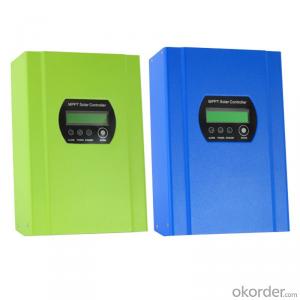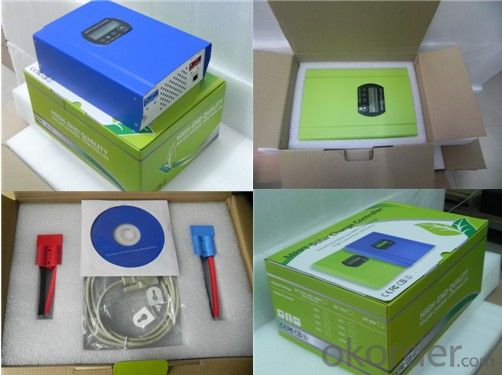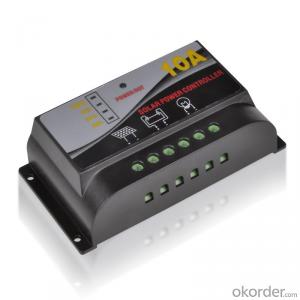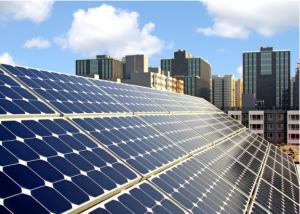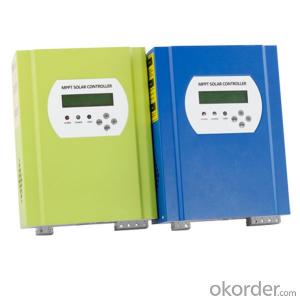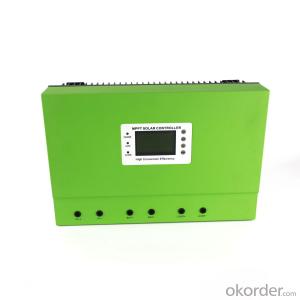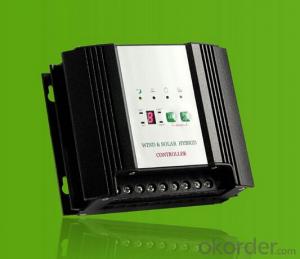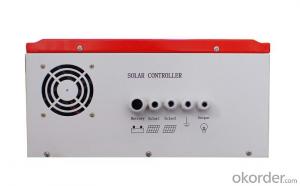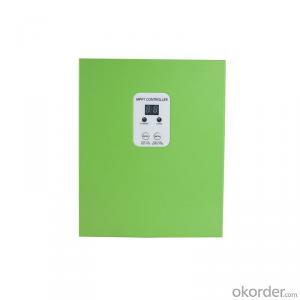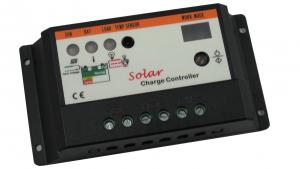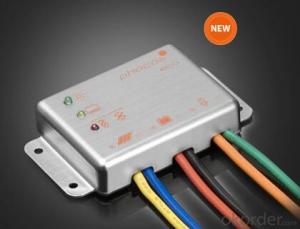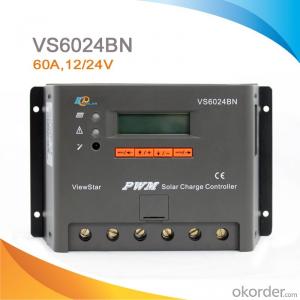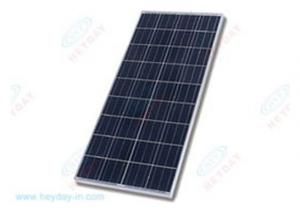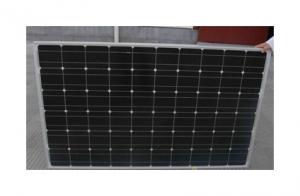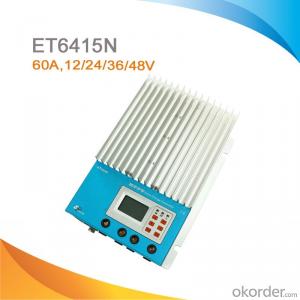Choosing Mppt Solar Controllers:Multifunctional 30A 12V 24V 48V Battery MPPT Solar Charge Controller 40A~60A
- Loading Port:
- China main port
- Payment Terms:
- TT OR LC
- Min Order Qty:
- 20 unit
- Supply Capability:
- 9999 unit/month
OKorder Service Pledge
OKorder Financial Service
You Might Also Like
solar power regulator controller,mppt charge controller 60A 12v/24v/48v mppt
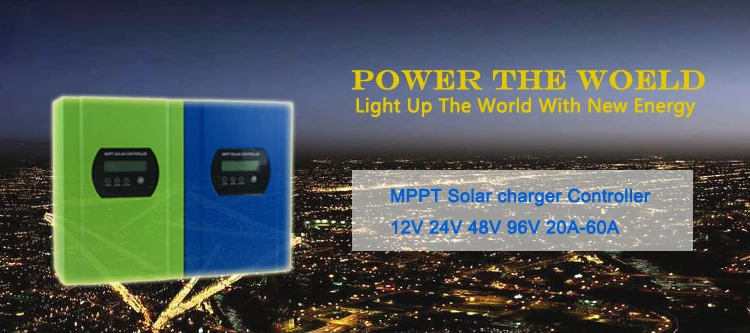
Hi, this is I-P- Smart1-DC12V/24V/48V-60A MPPT Solar Controller. With MPPT, it can target the highest output possibe from PV panels, make efficiency higher upto 30%~60% than traditional PWM ones. It can store energy to different kinds of batteries(Gel,Vented, Sealed,NiCd). More details please check the following information:
| Product Show |
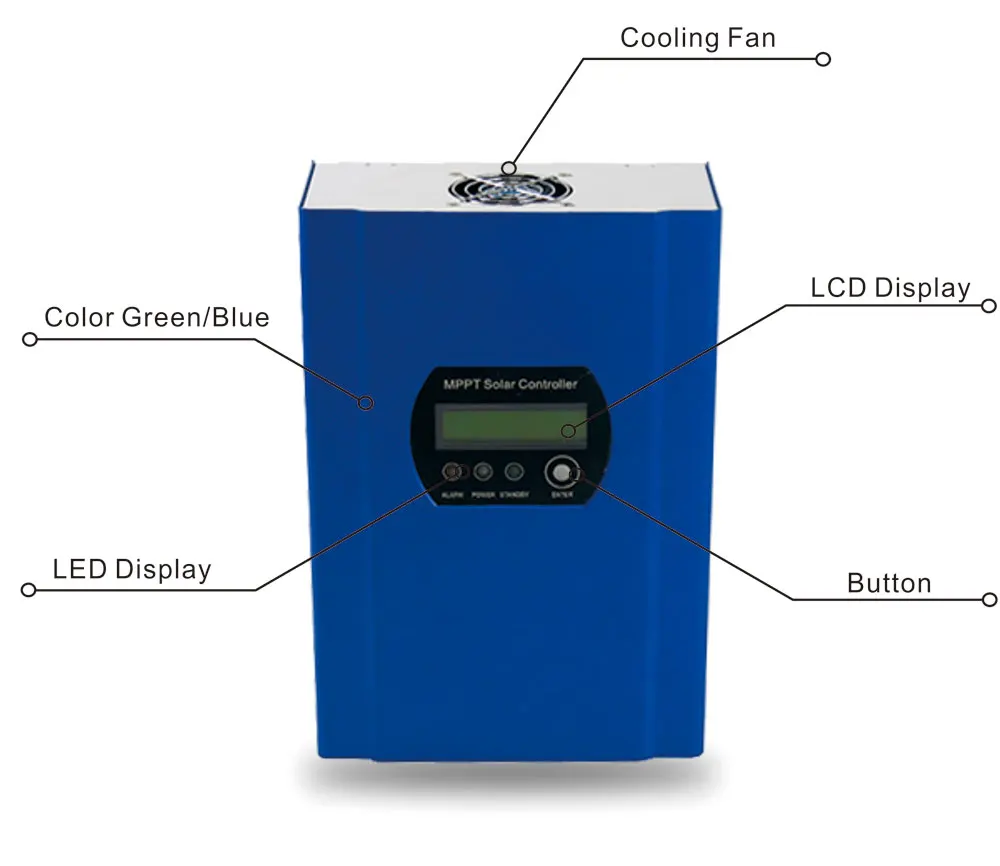
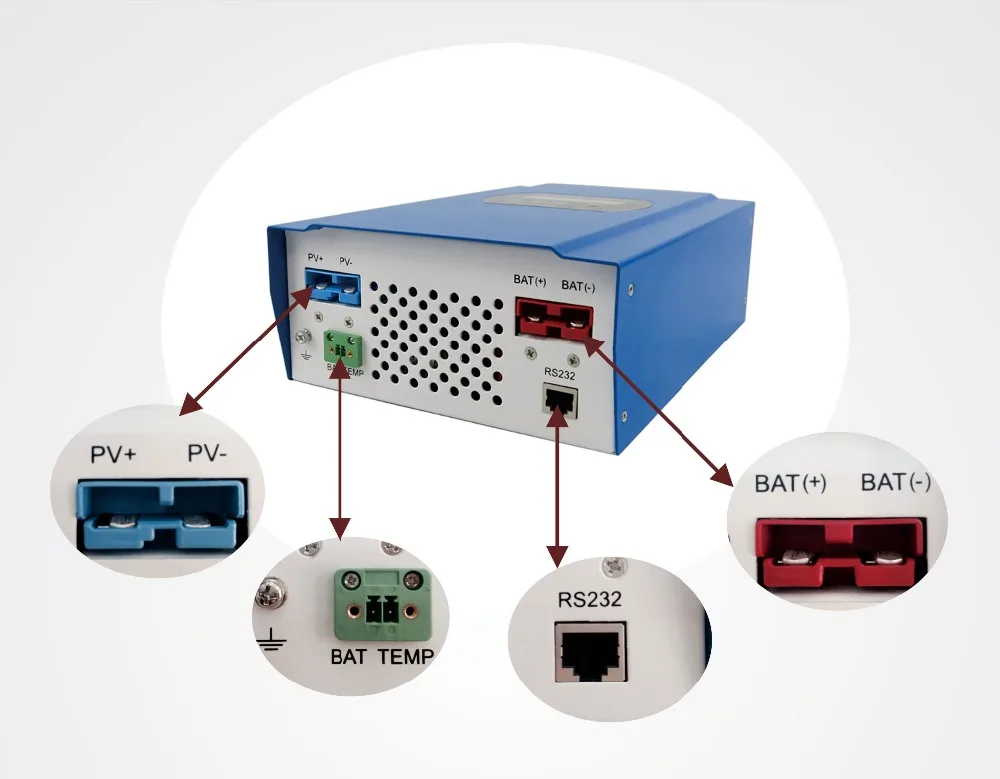
| Application |
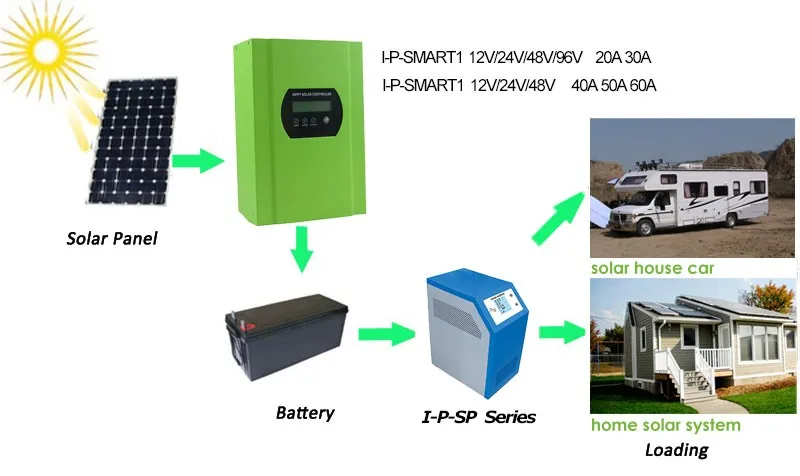
| Features |
1. Peak efficiency upto 99% with MPPT,increasing 30%~60% efficiency than traditional controller.
2. 12v/24v/48v system voltage automatic recognize.
3. Maximum input PV voltage upto DC150V.
4. 105degrees can be sufferred by good components.
5. Charge mode: three stages (fast charge, constant charge, floating charge)
6. Support kinds of batteries:Gel,Sealed lead acid,vented,NiCd,etc.
7. LCD and LED show parameters and system information,like PV input voltage,battery voltage,charge current,charge power,etc.
8. Port RS232 or connects to PC with upper software to show working state and parameters in 11 languages.
9. CE,RoHS certificatons approved.
10. 2 years warranty;3~10 years extended technical service.
RS232 Function working stat |
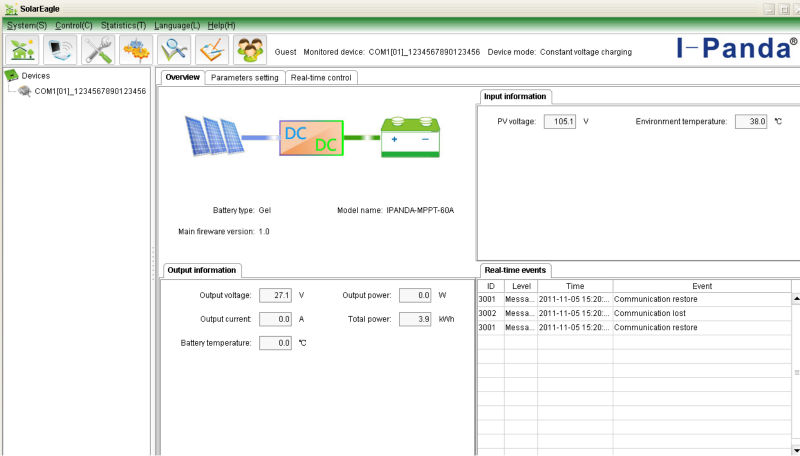
parameters |
Model:I-P-MSC-DC12V/24V/48V-series | 40A | 50A | 60A | ||||
Charge Mode | Maximum Power Point Tracking | ||||||
Method | 3 stages: fast charge(MPPT),constant voltage,floating charge | ||||||
System Type | DC12V/24V/48V | Automatic recognition | |||||
System Voltage | 12V system | DC9V~DC15V | |||||
24V system | DC18V~DC30V | ||||||
48Vsystem | DC36V~DC60V | ||||||
Soft Start Time | 12V/24V/48Vsystem | ≤10S | |||||
Dynamic Response Recovery Time | 12V/24V/48Vsystem | 500us | |||||
Conversion Efficiency | 12V/24V/48Vsystem | ≥96.5%,≤99% | |||||
PV Modules Utilization Rate | 12V/24V/48Vsystem | ≥99% | |||||
Input Characteristics | |||||||
MPPT Working Voltage and Range | 12V system | DC18V~DC150V | |||||
24V system | DC34~DC150V | ||||||
48V system | DC65~DC150V | ||||||
Low Voltage Input Protection Point | 12V system | DC16V | |||||
24V system | DC30V | ||||||
48V system | DC60V | ||||||
Low Voltage Input Recovery Point
| 12V system | DC22V | |||||
24V system | DC34V | ||||||
48V system | DC65V | ||||||
Max DC Voltage | 12V/24V/48V system | DC160V | |||||
Input Overvoltage Protection Point | 12V/24V/48V system | DC150V | |||||
Input Overvoltage Recovery Point | 12V/24V/48V system | DC145V | |||||
Max. PV Power | 12V system | 570W | 700W | 900W | |||
24V system | 1130W | 1400W | 1700W | ||||
48V system | 2270W | 2800W | 3400W | ||||
Output Characteristics | |||||||
Selectable Battery Types (Default type is GEL battery) | 12V/24V/48Vsystem | Sealed lead acid, vented, Gel, NiCd battery | |||||
Constant Voltage | 12V/24V/48V system | Please check the charge voltage according to the battery type form. | |||||
Floating Charge Voltage | 12V/24V/48V system | ||||||
Over Charge Protection Voltage | 12V system | 14.6V | |||||
24V system | 29.2V | ||||||
48V system | 58.4V | ||||||
Rated Output Current | 12V/24V/48V system | 40A | 50A | 60A | |||
Current-limiting Protection | 12V/24V/48V system | 44A | 55A | 66A | |||
Temperature Factor | 12V/24V/48V system | ±0.02%/℃ | |||||
Temperature Compensation | 12V/24V/48V system | 14.2V-(The highest temperature-25℃)*0.3 | |||||
Output Ripples(peak) | 12V/24V/48V system | 200mV | |||||
Output Voltage Stability Precision | 12V/24V/48V system | ≤±1.5% | |||||
Remark |
1. All the above parameters come from our former customers' requirements, if you have special need, we can adjust the parameter for you, such as DC voltage, charging current, etc.
2.Payment terms: 100% By T/T; 30% by T/T in advance, balance by T/T ; 100% Western Union;
3.Delivery Terms: EXWorks
4.Delivery Time: sample 1-2 working days after payment; big order depends on the quantity;
5.Providing OEM & ODM service;
Packaging & Shipping |
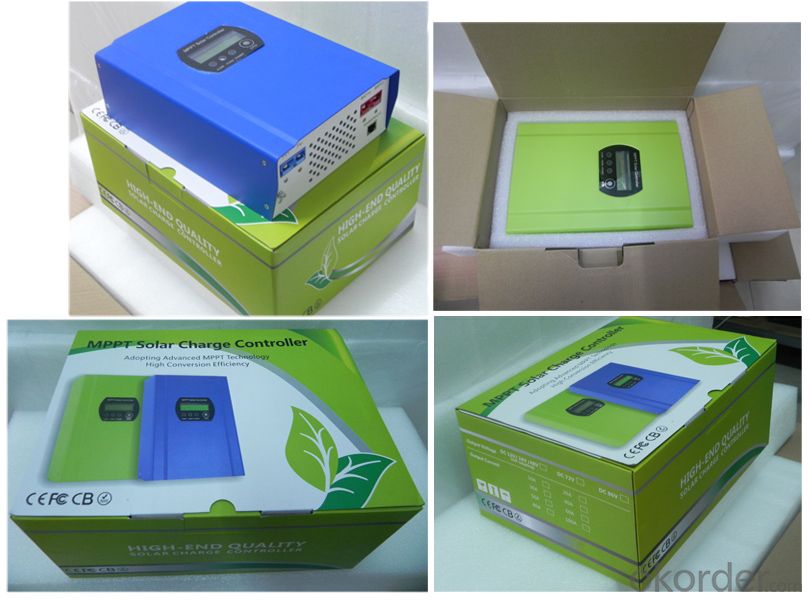
Certifications |
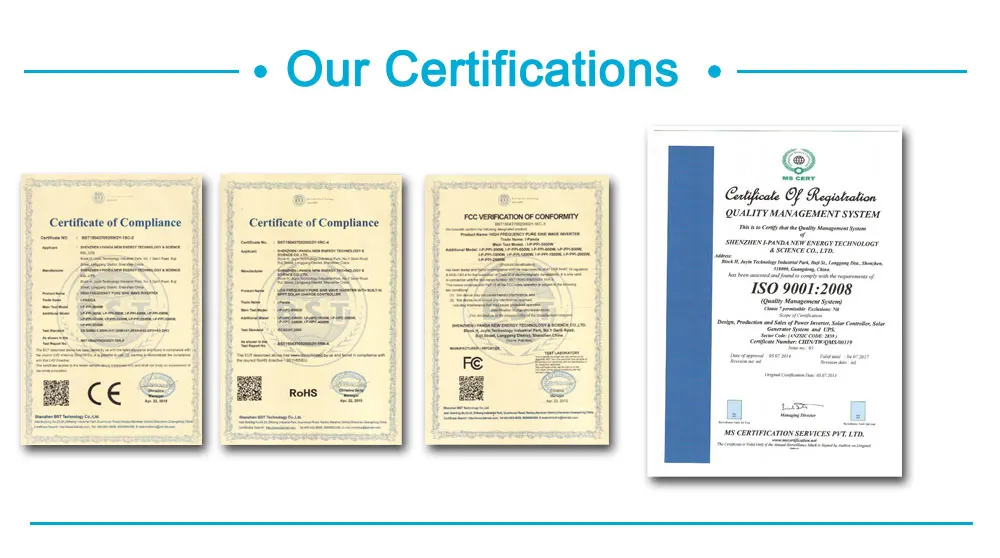
F&Q: |
Q1. How to ensure and monitor the products quality?
A1: We have established a perfect Quality Management System, In strict
accordance with ISO9001: 2008 quality system and ISO14001 environment system for quality assurance management;
Our ISO9001:2008 Quality System certificate encoding: CHIN/TW/QMS/00119;
Our ISO14001 Environment System certificate encoding: CHIN/TW/EMS/00028;
Q2. What is the warranty of products?
A2: The warranty period of different products are different; 5 years, 3 years, 2 years, 1 years; More details please refer to the product specification or manual; we will provide free life-long technical support ;
Q3. What is the difference between MPPT&PWM?
A3. MPPT charging mode, peak efficiency up to 99%, saving 30%~60% solar panel than traditional PWM controller.
- Q: What is the maximum number of system alarms supported by a solar controller?
- The maximum number of system alarms supported by a solar controller can vary depending on the specific model and brand. However, most solar controllers typically support a range of 10 to 20 system alarms.
- Q: What is the role of a battery equalization function in a solar controller?
- The role of a battery equalization function in a solar controller is to ensure that each individual battery within a battery bank is charged and discharged evenly. This function helps to balance the voltage levels across all the batteries, maximizing their overall lifespan and performance. By equalizing the charge levels, the battery equalization function helps to prevent overcharging or undercharging of specific batteries, which can lead to premature failure or reduced capacity.
- Q: Can a solar controller be used with solar-powered indoor cultural facilities?
- Solar-powered indoor cultural facilities can indeed utilize a solar controller. The purpose of a solar controller is to regulate the charging and discharging of batteries within a solar power system. Traditionally, solar power has been associated with outdoor applications such as residential or commercial buildings. However, it can also be effectively employed in indoor cultural facilities such as museums, art galleries, libraries, or exhibition halls that prioritize sustainability and environmental friendliness. Implementing a solar controller in these facilities offers several advantages. Firstly, it ensures that the solar panels efficiently convert sunlight into electricity and effectively charge the batteries. By controlling the energy flow, it prevents overcharging, which can potentially harm the batteries. As a result, a reliable and consistent power supply is guaranteed for the indoor cultural facility. Furthermore, a solar controller aids in monitoring the energy consumption of the facility. It provides real-time data on solar power generation, battery status, and overall energy usage. This valuable information enables facility managers to optimize energy consumption, identify any potential issues, and make well-informed decisions to enhance energy efficiency. Moreover, solar controllers often come equipped with built-in features like load control and timers. This allows facility managers to exercise control over the utilization of solar power within the indoor cultural facility. For instance, lights or climate control systems can be programmed to operate during specific hours or only when necessary. This approach minimizes energy wastage and maximizes the utilization of solar power. In conclusion, there is no doubt that a solar controller can be effectively employed in solar-powered indoor cultural facilities. It facilitates efficient energy conversion, enables energy consumption monitoring, and empowers control over solar power usage. By embracing the use of a solar controller, indoor cultural facilities can become more sustainable, reduce their environmental impact, and simultaneously maintain a reliable power supply.
- Q: Can a solar controller be used with solar panels that are connected to a solar lighting system?
- Using a solar controller with solar panels connected to a solar lighting system is possible. A solar controller, also referred to as a charge controller, is a vital component of a solar power system. It regulates the flow of electrical energy between the solar panels, battery storage, and other devices. Its purpose is to prevent the batteries from being overcharged or over-discharged, which can result in damage and a shorter lifespan. In the context of a solar lighting system, the solar controller plays a crucial role in managing the charging and discharging cycles of the batteries. These batteries store the energy generated by the solar panels during the day. The solar controller ensures that the batteries are optimally charged from the solar panels and that the stored energy is efficiently utilized for lighting purposes during nighttime. By utilizing a solar controller, the efficiency and lifespan of the solar lighting system can be maximized. It achieves this by safeguarding the batteries against excessive voltage and current fluctuations. Some solar controllers also offer additional features, such as load control. This feature allows users to manage the power consumption of the lighting system, ultimately extending the battery life. Therefore, it is highly recommended to incorporate a solar controller into a solar lighting system that is connected to solar panels. This ensures proper and efficient operation of the system.
- Q: What is the role of a battery capacity monitor in a solar controller?
- The role of a battery capacity monitor in a solar controller is to accurately measure and report the level of charge in the battery bank. It helps to prevent overcharging or over-discharging of the batteries, which can lead to reduced lifespan and performance. The monitor allows the solar controller to efficiently regulate the charging and discharging process, ensuring that the batteries are maintained at optimal levels for maximum efficiency and longevity.
- Q: What is the maximum input voltage for a solar controller with an LCD display?
- The maximum input voltage for a solar controller with an LCD display typically depends on the specific model and manufacturer. It is important to consult the product specifications or user manual for accurate information regarding the maximum input voltage.
- Q: How does a solar controller handle battery over-discharge protection?
- A solar controller handles battery over-discharge protection by monitoring the voltage level of the battery. When the voltage drops below a certain threshold, the controller will automatically disconnect the battery from the solar panel to prevent further discharge. This helps to prolong the battery's lifespan and prevent damage from excessive discharge.
- Q: Can a solar controller be used with solar-powered telecommunications systems?
- Yes, a solar controller can definitely be used with solar-powered telecommunications systems. A solar controller helps regulate the charging and discharging of batteries in a solar power system, ensuring that the batteries are properly charged while protecting them from overcharging or discharging. This is especially important for solar-powered telecommunications systems that rely on uninterrupted power supply to function properly. By using a solar controller, these systems can efficiently utilize the energy generated from the solar panels, extending the lifespan of the batteries and maintaining reliable power for the telecommunications equipment.
- Q: How do I protect a solar controller from power surges?
- To safeguard your solar controller against power surges, several preventative actions can be taken: 1. Incorporate a surge protector: Consider installing a specialized surge protector designed specifically for solar systems. These protectors are placed between the solar panels and the solar controller, serving as a barrier against power surges. They effectively redirect excessive voltage, preventing any harm to the controller. 2. Ensure proper grounding: Guarantee that your solar system is adequately grounded. Grounding establishes a pathway for the surplus electrical energy to safely discharge into the ground, minimizing the risk of damage to the solar controller. Consult a professional electrician or adhere to the manufacturer's guidelines to ensure the correct grounding procedures. 3. Implement lightning protection: Lightning strikes can result in significant power surges, thus it is vital to have appropriate lightning protection measures in place. Install lightning rods or conductive systems that safely direct the lightning strike towards the ground, away from the solar controller and other equipment. 4. Regularly maintain and inspect: Conduct routine inspections of your solar system to identify any potential issues or damage. Examine for loose connections, corroded wires, or any indications of wear and tear that may heighten susceptibility to power surges. Promptly address and rectify any damaged components to prevent further harm. 5. Consider an overvoltage protection device: Another option is to install an overvoltage protection device (OVPD) specifically designed for solar systems. OVPDs continuously monitor voltage levels and disconnect the solar panels from the controller when the voltage surpasses a safe threshold. This effectively safeguards the controller from power surges and excessive voltage. It is important to bear in mind that although these measures significantly mitigate the risk of damage from power surges, they do not guarantee complete protection. In extreme cases, such as severe lightning strikes, some damage may still occur. Hence, it is crucial to possess appropriate insurance coverage and seek advice from professionals regarding installation and protection measures.
- Q: Can a solar controller be used with a solar heating system?
- Yes, a solar controller can be used with a solar heating system. A solar controller is designed to regulate and control the flow of energy between the solar panels and the heating system, ensuring optimal performance and efficiency. It helps monitor and adjust the temperature, flow rate, and other parameters to ensure effective utilization of solar energy for heating purposes.
Send your message to us
Choosing Mppt Solar Controllers:Multifunctional 30A 12V 24V 48V Battery MPPT Solar Charge Controller 40A~60A
- Loading Port:
- China main port
- Payment Terms:
- TT OR LC
- Min Order Qty:
- 20 unit
- Supply Capability:
- 9999 unit/month
OKorder Service Pledge
OKorder Financial Service
Similar products
Hot products
Hot Searches
Related keywords
